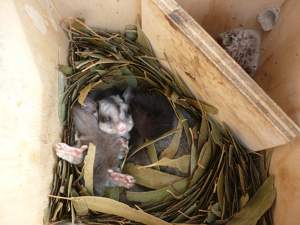Rushworth P-12 College students recently built 21 new nest boxes that will provide valuable shelter for the region’s threatened squirrel glider population.
![]()

Goulburn Broken Catchment Management Authority Conservation Management Network (CMN) Co-ordinator Janice Mentiplay-Smith said the workshop was organised as part of the Whroo Goldfields CMN’s Gliders in the Goldfields project, which is funded through the Victorian Government’s Communities for Nature initiative.
“The box-ironbark forests around the Rushworth area have very few large old trees with the hollows that so many native species need for shelter and breeding,” Ms Mentiplay-Smith said. “This project will result in 90 new nest boxes being installed on private land to provide habitat for a range of hollow-dependent species. By increasing and improving habitat, the number of gliders that can survive and thrive will increase.”
Ms Mentiplay-Smith said the school and its students had been great supporters of the project.
“The enthusiasm and interest of the students is amazing. They are so keen to build the nest boxes, and interested to learn about the species that will move into them. Sometimes we have nest boxes installed for only six weeks in the region, before a native marsupial moves in, so the students know that their boxes will most likely be occupied very soon, and that gives them a feeling that they are doing something tangible.”
The Gliders in the Goldfields project complements previous projects that involved building nest boxes for the forest’s brush-tailed phascogale and sugar gliders populations.
“About 60 sugar glider and brush-tailed phascogale nest boxes have already been installed around the Rushworth region and monitoring indicates that more than half are already being used by gliders and phascogales, as well as many other native species,” she said. “We really appreciate the support of the community: the students and groups who build and install the nest boxes as well as the landholders who monitor the occupancy of the boxes and maintain them. This effort is critically important to protecting and improving habitat for these threatened species.”
To find out more about the project, contact Janice Mentiplay-Smith on janicem@gbcma.vic.gov.au or 5764 7506 or visit http://www.whroogoldfieldscmn.com/
Did you know?
Squirrel gliders:
- are nocturnal, omnivorous marsupials, that feed on invertebrates, eucalypt pollen, sap, nectar, birds eggs and young, and gum from acacias and eucalypts (to access the sap, they make incisions in the bark with their strong teeth);
- are arboreal, carrying out the majority of activities in tree tops and along tree trunks;
- will usually nest alone and alternate between a range of hollows at various heights in living or dead trees; and
- prefer hollows with a small (50-60 mm) diameter entrance, to deter predators.